The 1-4-4-2 formation is one of football’s most iconic and enduring tactical setups. Known for its balance between defense and attack, this formation has been a favorite of coaches and teams for decades. In this article, we’ll break down the key elements of the 1-4-4-2, exploring how it works, its strengths and weaknesses, and why it remains a go-to choice for teams aiming to control the game on both ends of the pitch. Whether you’re a player, coach, or fan, understanding this formation will give you deeper insight into the beautiful game.
Defending in the 1-4-4-2 Formation
Defending in the 1-4-4-2 formation is all about balance, compactness, and discipline. It requires teamwork and communication, as well as a clear understanding of each player’s role within the defensive structure. When executed correctly, it provides a robust and resilient defensive strategy that can stifle even the most potent attacking teams.
In the 1-4-4-2 formation, the team defends in two compact lines of four, with the forwards positioned ahead of the midfield. The back four consists of two central defenders and two fullbacks, while the midfield four are usually arranged in a flat line across the pitch. The two forwards play a crucial role, not only as the first line of defense but also in initiating the team’s pressing strategy.
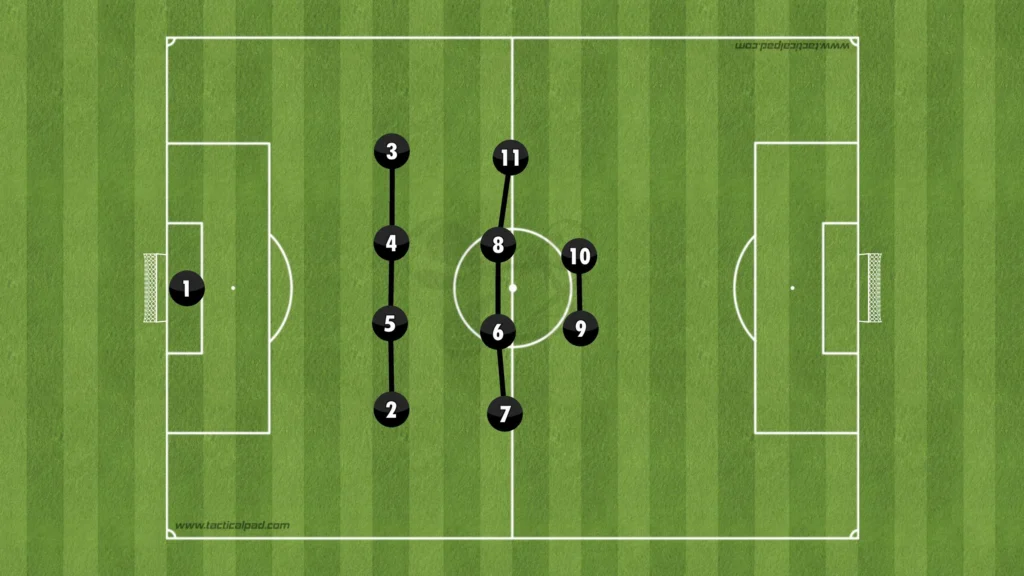
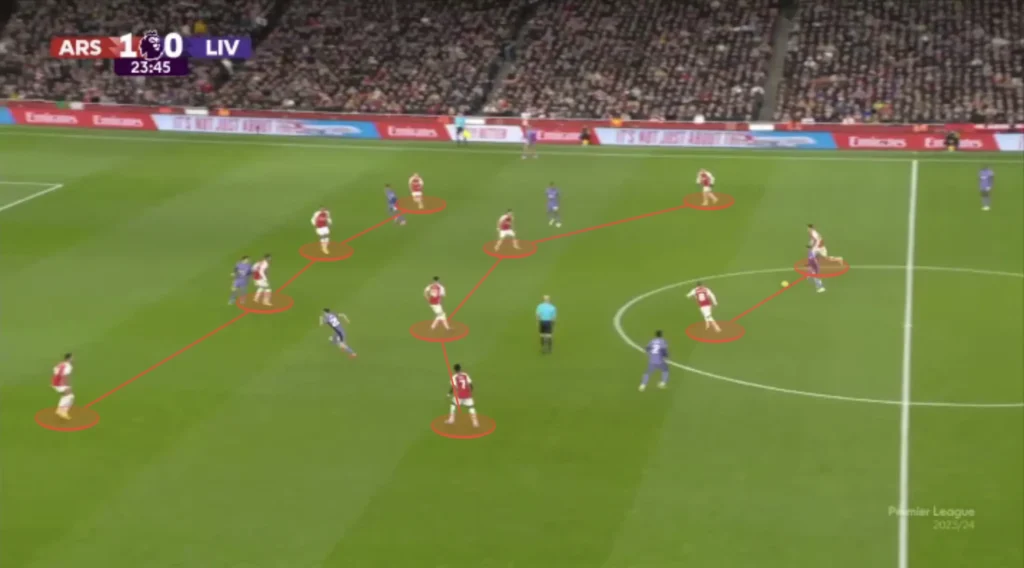
Maintaining Compactness and Forcing the Play Wide
One of the primary strengths of the 1-4-4-2 is its ability to maintain compactness. The two banks of four stay close together, minimizing the space between the lines and making it difficult for the opposition to play through the middle. This compactness helps protect the central areas, forcing opponents to attempt riskier passes or play out wide, where it’s easier to isolate and pressure them.
Additionally, the two forwards can work together to force the opposition’s center-backs to play the ball wide rather than through the middle. This is a key aspect of defending in the 1-4-4-2, as it helps funnel the play into areas where the team is more likely to regain possession. The wide midfielders support this effort by closing down the opposition’s fullbacks or wide players, preventing easy progress down the flanks.
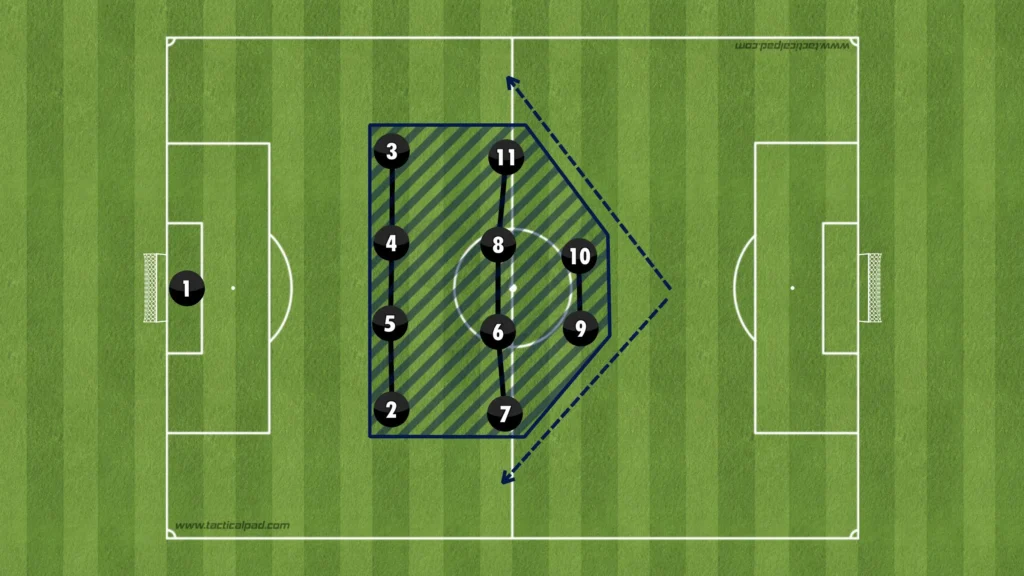
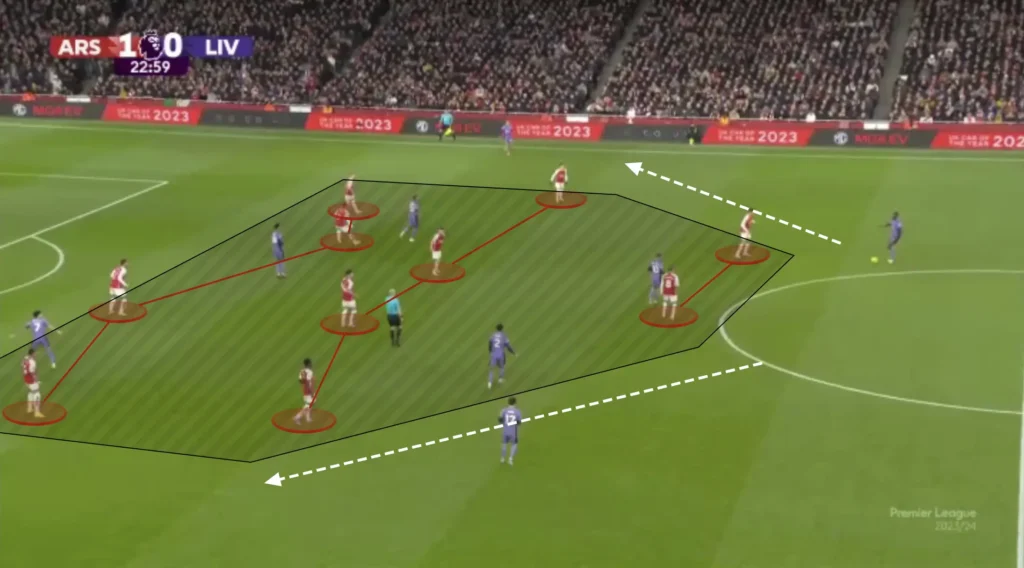
Player Responsibilities
Role of the Defenders
The back four are crucial in maintaining a solid defensive line. The two center-backs are responsible for marking the opposition strikers and clearing any crosses or through-balls that come into the box. The fullbacks, meanwhile, are tasked with closing down wingers and preventing crosses from coming in. They also need to be aware of overlapping runs from the opposition fullbacks.
Role of the Midfielders
The four midfielders play a critical role in the defensive phase. The two central midfielders act as the first line of defense in front of the back four, breaking up play, intercepting passes, and preventing the opposition’s attacking midfielders from getting on the ball in dangerous areas. They must be disciplined in their positioning, staying close together to block passing lanes and protect the central areas.
The wide midfielders have dual responsibilities: helping the fullbacks in wide areas and tracking back to defend against opposition wingers and overlapping fullbacks. They also need to support the central midfielders, tucking in when necessary to maintain the compact shape of the team.
Role of the Forwards
In the 1-4-4-2 formation, the two forwards are the first line of defense. Their job is to apply pressure on the opposition’s center-backs and force them to play the ball wide or backward. This press can disrupt the opposition’s build-up play and lead to turnovers in dangerous areas. When not pressing, the forwards must drop slightly to help screen the opposition’s central midfielders, cutting off passing lanes into the midfield and ensuring that the team remains compact from front to back.
Weaknesses and Considerations
While the 1-4-4-2 is solid defensively, it does have some vulnerabilities. The formation can be susceptible to teams that excel at switching play, as the wide areas can be exposed if the midfielders are too narrow.
Additionally, when up against formations with three or more central midfielders, the two central midfielders in a 1-4-4-2 can be outnumbered, leading to difficulties in maintaining control of the midfield.
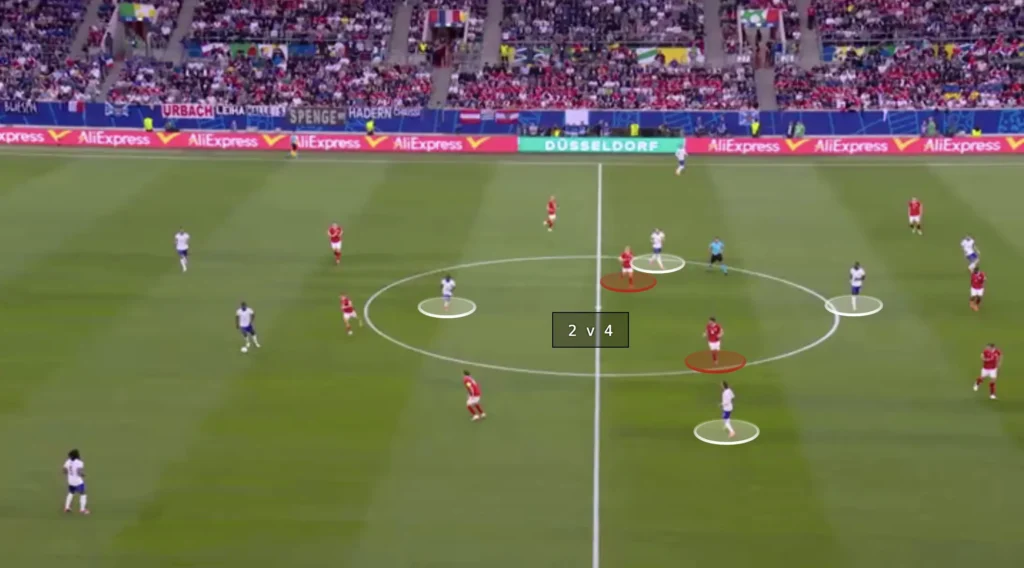
High Pressing in the 1-4-4-2 Formation
When pressing in the 1-4-4-2 formation, the main idea is to force the opposition into areas of the pitch where they are most likely to make mistakes. This usually means channeling the play towards the touchlines, where the pressing team can use the sideline as an extra defender.
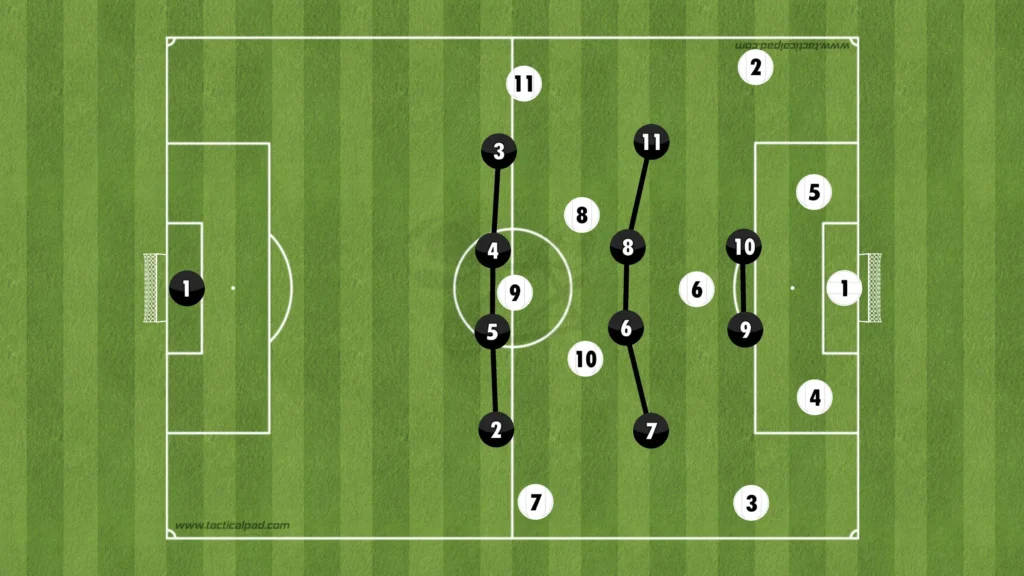
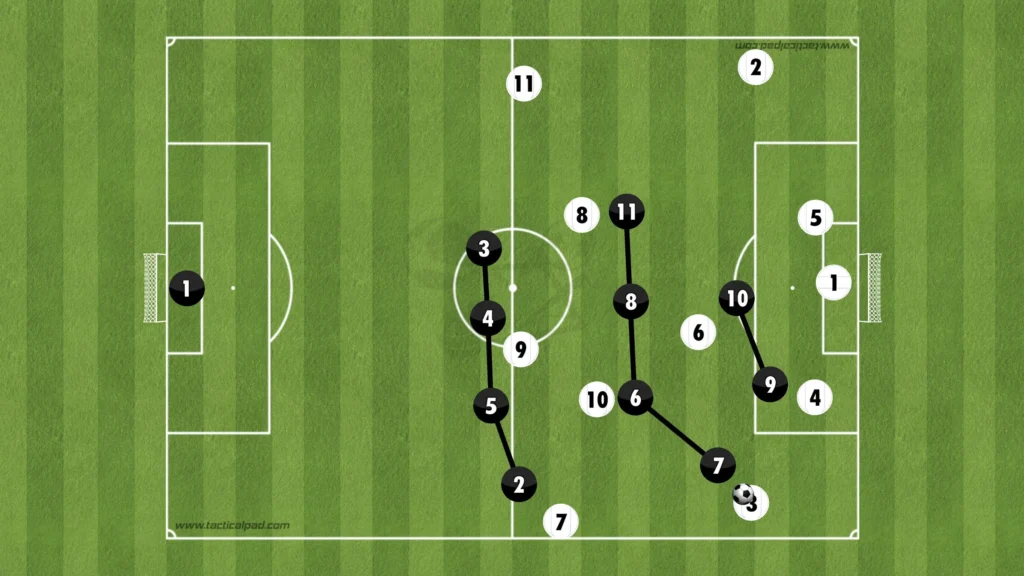
The goal is to isolate the ball-carrier, limit their passing options, and force them into a turnover or a risky pass that can be intercepted. When you push the opposition to one side, you leave the opposition players on the far side open. This is possible because the pass from one side to the other is too difficult for the ball-holder to make, and if he makes it, the players will have enough time to come across and win the ball. The benefit of this system is that it gives you a numerical advantage against the opposition attackers, which gives you more control when defending long balls.
The most important thing when pressing in a 1-4-4-2 formation is to close the switch of play. If the opposition switches the ball from one fullback to the other, the players have to come across too far for the team to keep pressing the opposition. Therefore, the strikers must force the ball to one side and then close the back pass to the center-backs. The midfielders must also be very close to their opponents, not allowing them to turn and switch the play.
Counterattacks
Counterattacking in the 1-4-4-2 formation is a classic strategy that capitalizes on the formation’s balance and directness. This setup is particularly effective for teams looking to quickly exploit the opposition’s vulnerabilities after regaining possession. When executed properly, it can be a highly effective strategy, capable of breaking down even the most organized defenses.
Utilizing the Strikers
In a 1-4-4-2 counterattack, the two strikers play a pivotal role. Their primary task is to stretch the opposition’s defense, creating space either by running in behind the backline or by dropping deep to link up with the midfielders. The partnership between the strikers is crucial; they must work together to exploit gaps in the defense, often with one striker pulling defenders away to create space for the other. Additionally, many opponents will use two center-backs in the build-up, meaning there will be a 2v2 up top on the counterattacks. If one of the strikers can beat his center-back 1v1, he will be through on goal and in a good position to score.
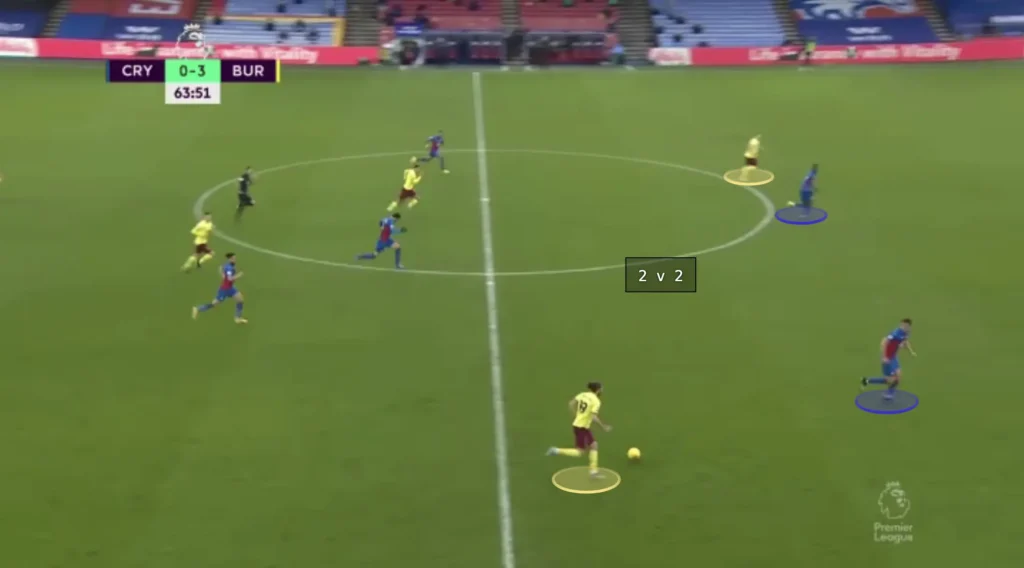
Support from Midfield
The midfielders in a 1-4-4-2 formation are responsible for quickly joining the strikers in counterattacking situations. The wide midfielders/wingers provide width, stretching the play and delivering crosses into the box, while the central midfielders push forward to support the strikers or exploit the spaces left by the opposition. This setup allows for various attacking options, whether it’s a quick through ball, a cross from the flanks, or a long ball over the top to the strikers.
Build-up
Building up in a 1-4-4-2 formation revolves around creating balance and maintaining solid defensive cover while progressing the ball through the thirds. The formation typically employs two banks of four, with the midfielders and fullbacks playing crucial roles in linking defense to attack. During the build-up, the center-backs often split wide to offer passing lanes, while the fullbacks push higher up the pitch to provide width. The two central midfielders, responsible for both defensive duties and playmaking, drop deeper to support the defense and offer passing options. The two strikers stay advanced, ready to receive long balls or exploit spaces left by the opposition. This setup allows for both short, controlled build-ups through the midfield or more direct play, depending on the opposition’s pressing strategy. The 1-4-4-2 formation’s flexibility makes it effective in transitioning from defense to attack while maintaining a solid defensive shape.
Low Build-up
The 1-4-4-2/1-4-2-4 formation is becoming more and more popular in the low build-up. If the strikers play high and the wingers wide, a big space between the opposition’s backline and midfield will appear. The attackers can drop into this space and receive the ball from the backline, looking to play it back to one of the holding midfielders and go at the opposition from there.
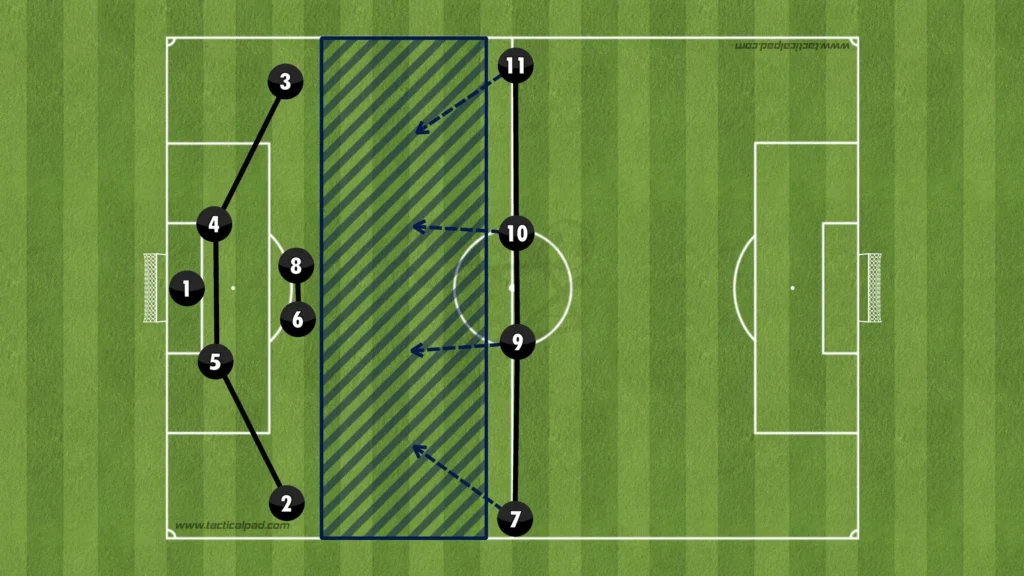
Low build-up vs 1-4-3-3 press
If the opposition comes up and presses in a 1-4-3-3 formation, there will be a numerical disadvantage up top but a numerical advantage at the back. The goalkeeper and center-backs can create a 3v1 against the opposition striker and use that numerical advantage to find a free center-back who can take the ball forward past the striker.
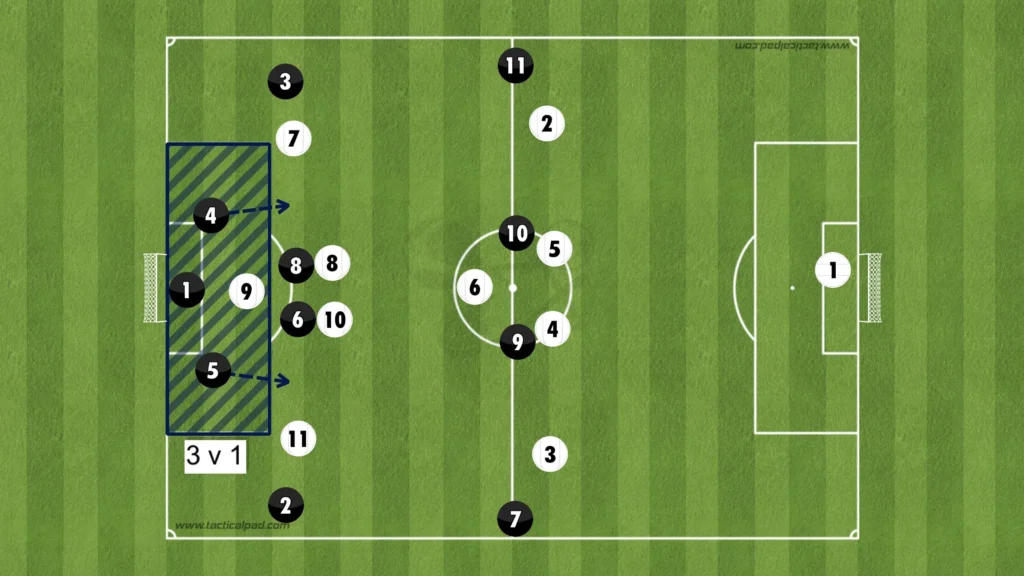
From there, the center-back will attract the press from a new opponent, which opens the space for a teammate. If the opposition winger pushes up to press the center-back, the fullback will be open, and a third-man combination involving a dropping striker could be used to find him.
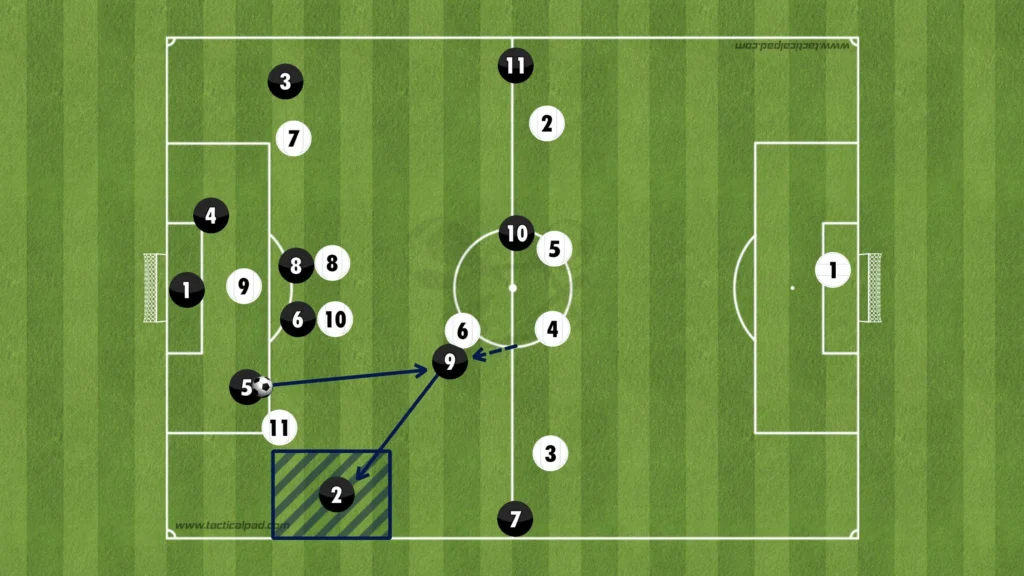
If an opposition attacking midfielder pushes up to press, a holding midfielder will be open, and the striker could again drop and be used as the third-man to find the free player.
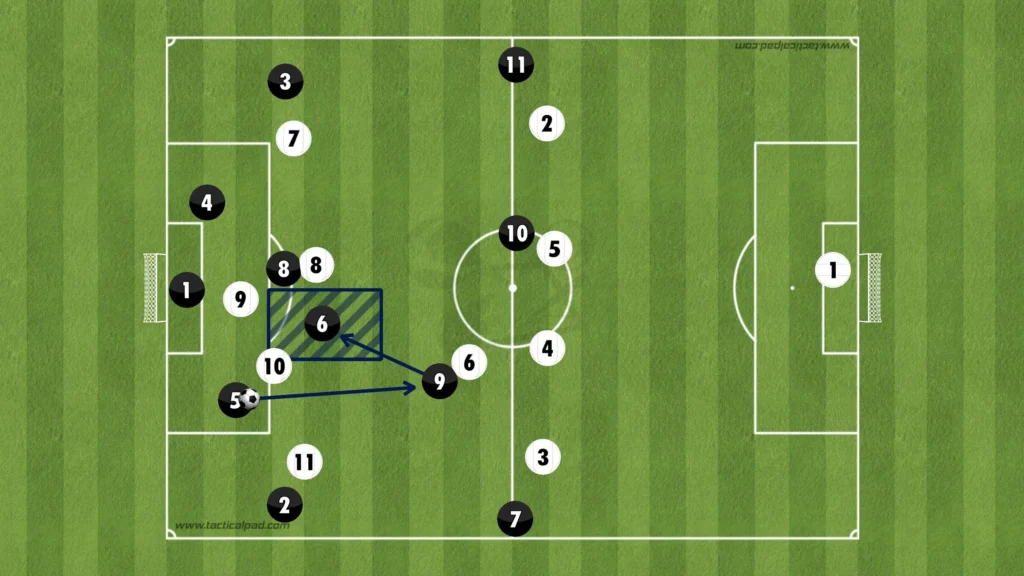
Low build-up vs man-to-man system (numerical equality)
If the opposition comes up and presses man-to-man, there will be numerical equality all over the pitch. The only place where a numerical advantage could be made is in your own penalty area with the goalkeeper and center-backs against the opposition strikers.
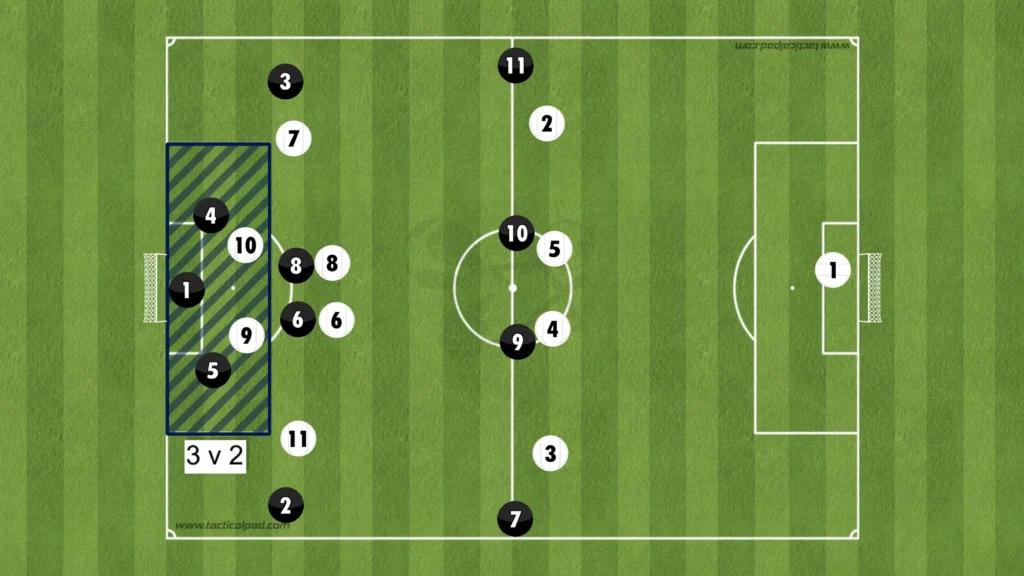
This 3v2 can be exploited to find a free center-back who can take the ball forward. Firstly, the center-back can play the ball to the goalkeeper who waits for one of the strikers to press him. This means the center-back the striker was marking will be free. The pressing striker will block the passing lane from the goalkeeper to the center-back, which means a third-man has to come and connect. The goalkeeper can play the ball to one of the holding midfielders, who can play a one-touch pass to the open center-back, beating the striker’s press.
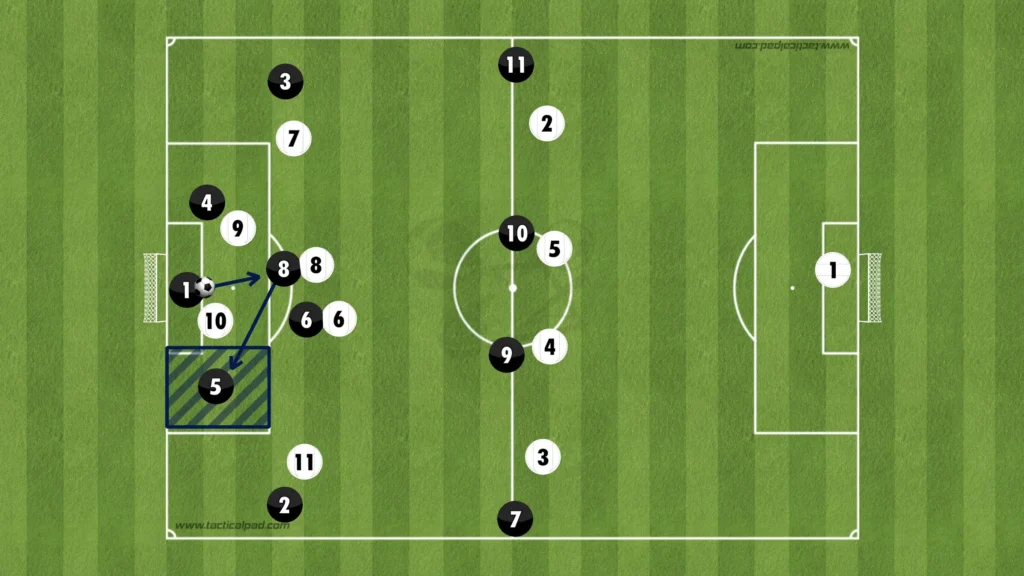
From there, the center-back can take the ball forward and attract the press from a new opponent, which opens the space for a teammate. If the opposition winger pushes up to press the center-back, a third-man combination involving the dropping striker could be used to find the open fullback. If the opposition attacking midfielder pushes up to press, the striker could be used as the third-man to find the free holding midfielder.
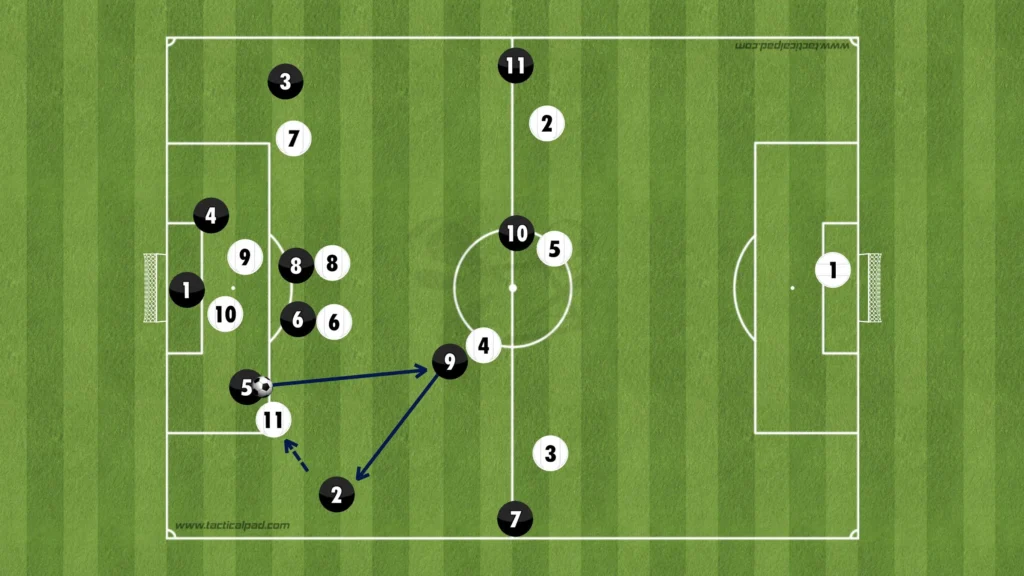
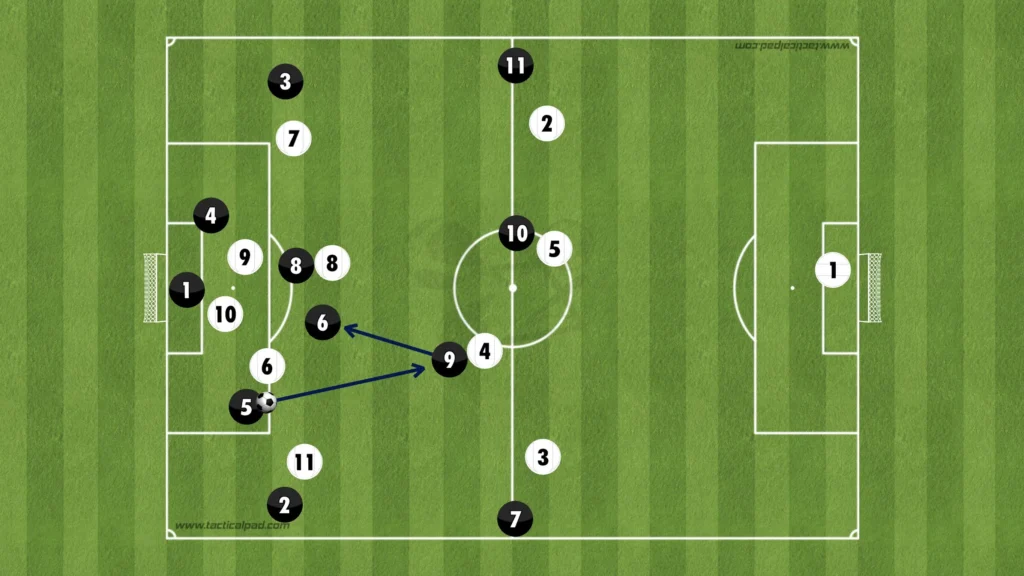
Going long
Building up like this is great in theory but requires massive concentration, training, and technique. One bad pass or bad touch will lead to a certain goal. To avoid that risk, many teams go long when building up against a man-to-man system. The benefit of building in a 1-4-4-2 formation is that it can be manipulated with small movements to open up more space for the attackers, giving more threat to these long balls. If the strikers drop into the midfield, the attacking team will be in a 1-4-2-2-2 formation with two number-tens and two high wingers in the low build-up.
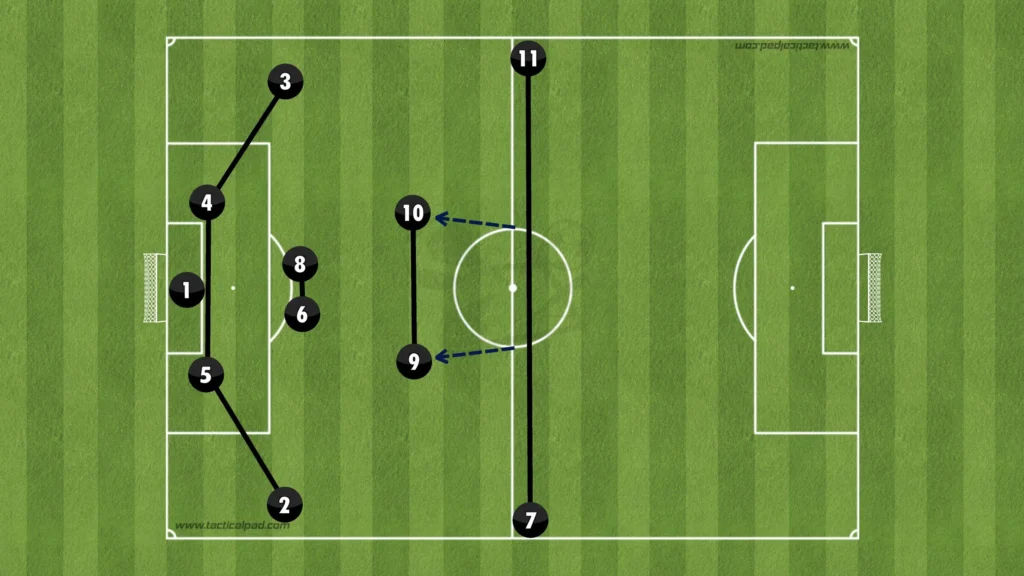
This structure questions the opposition center-backs, forcing them to make difficult decisions. If they push up on the dropping strikers, the space behind them opens up, giving the winger a 1v1 against the fullback in a massive space.
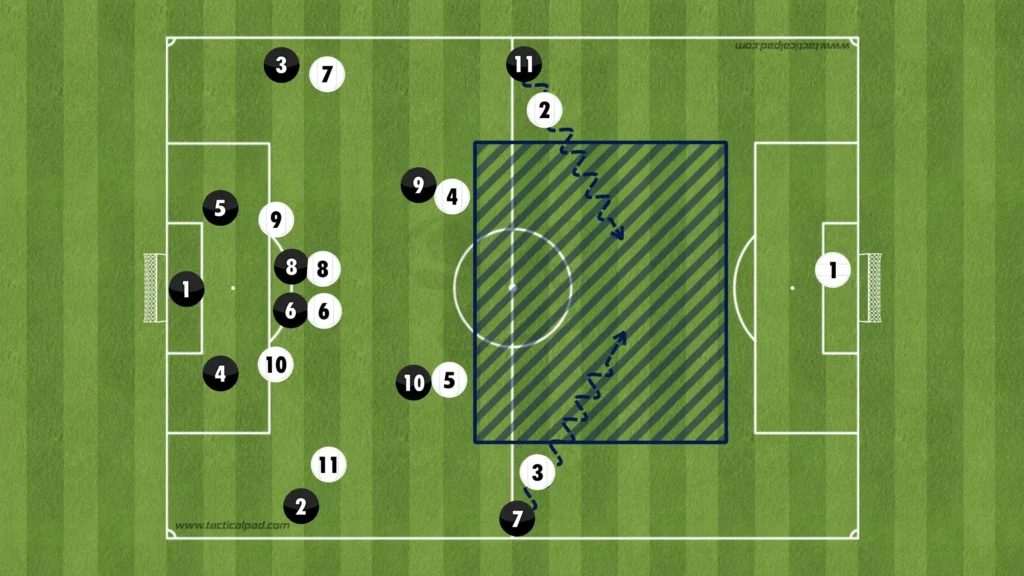
However, if they do not push up, a numerical superiority is created in the midfield, allowing the attacking team to find the strikers and play through the press.
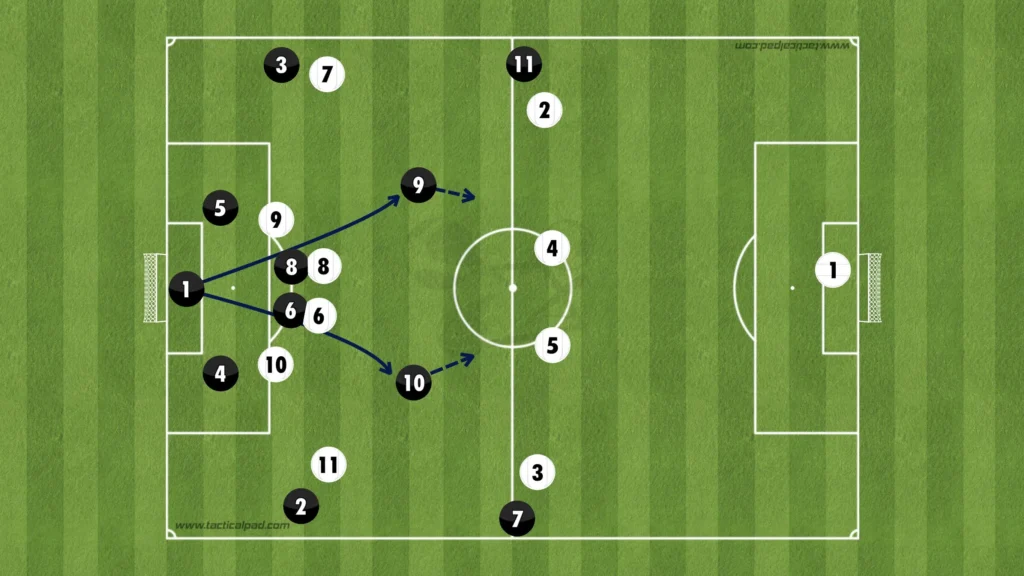
Here, De Zerbi’s Brighton exploits the space in behind by playing a through-ball from the goalkeeper to the winger into the space that Brentford’s pushing center-backs have opened.
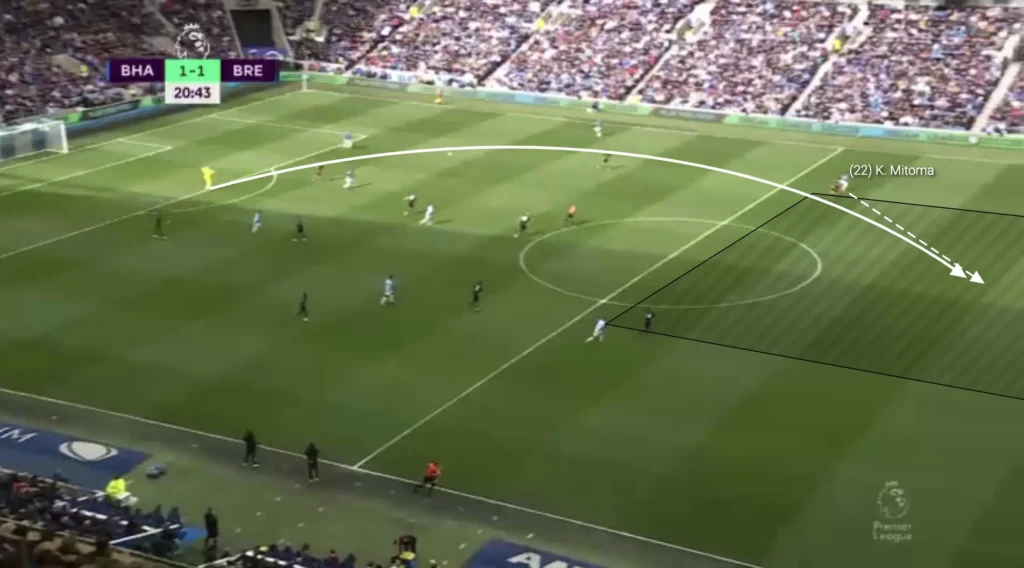
High Build-up
The 1-4-4-2 formation offers much flexibility in the high build-up. The wingers can play high and wide to stretch the opposition’s backline or come inside to create overloads in the middle. A holding midfielder can drop into the backline, allowing the fullbacks to either push up or come into the midfield. The strikers could also make runs in behind or drop into the midfield to create overloads.
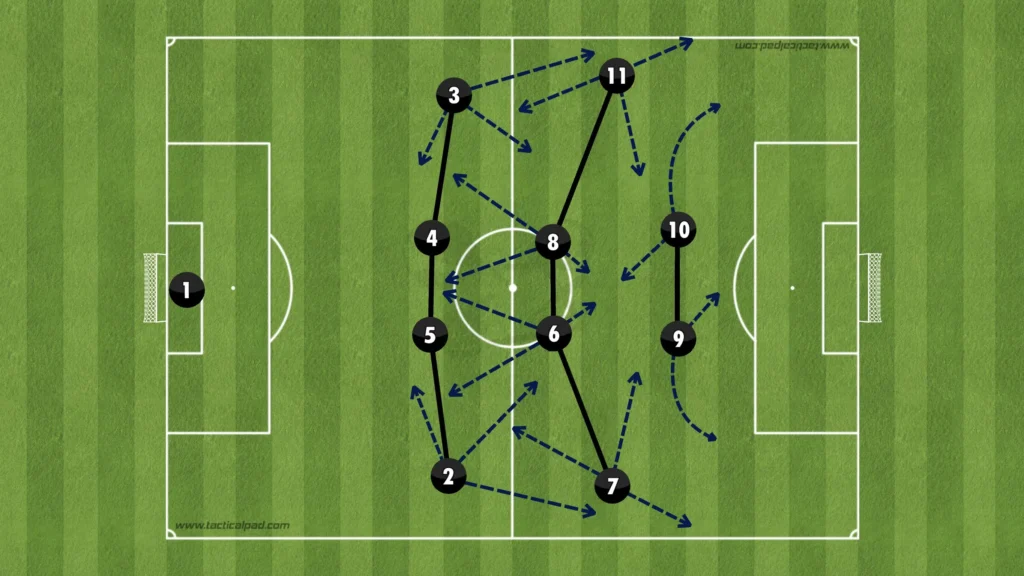
Striker teamwork
In the 1-4-4-2 formation, the teamwork between the two strikers is crucial for the success of the team’s attack. Positioned closely together, these forwards need to develop a strong understanding of each other’s movements to create space and exploit defensive gaps. This interplay allows them to combine quickly in tight spaces, exchange quick passes, and create goal-scoring opportunities. One striker can drop deeper while the other stays high to pin the center-backs. This creates space for the dropping striker between the lines, allowing him to get the ball, turn and attack the backline.
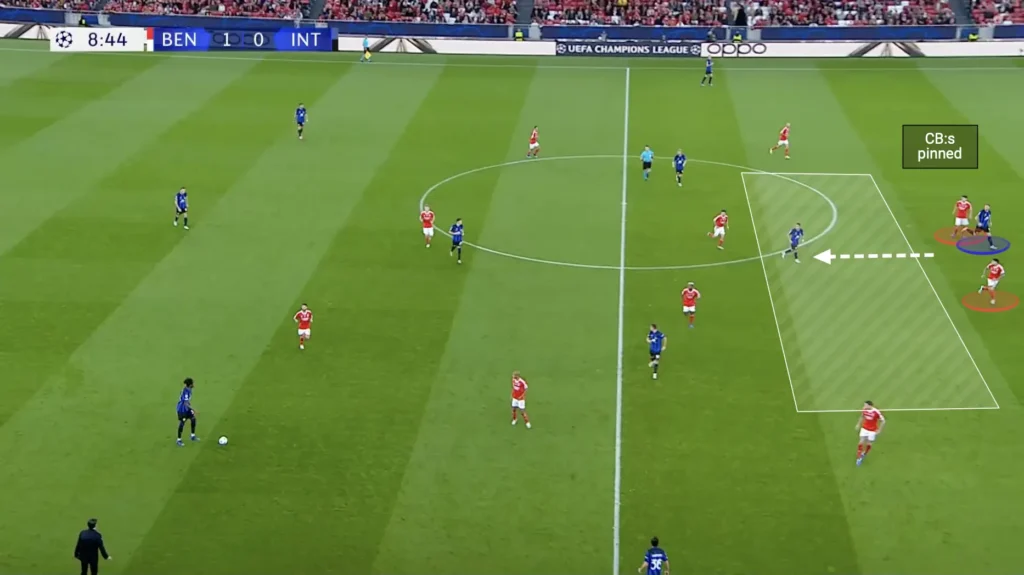
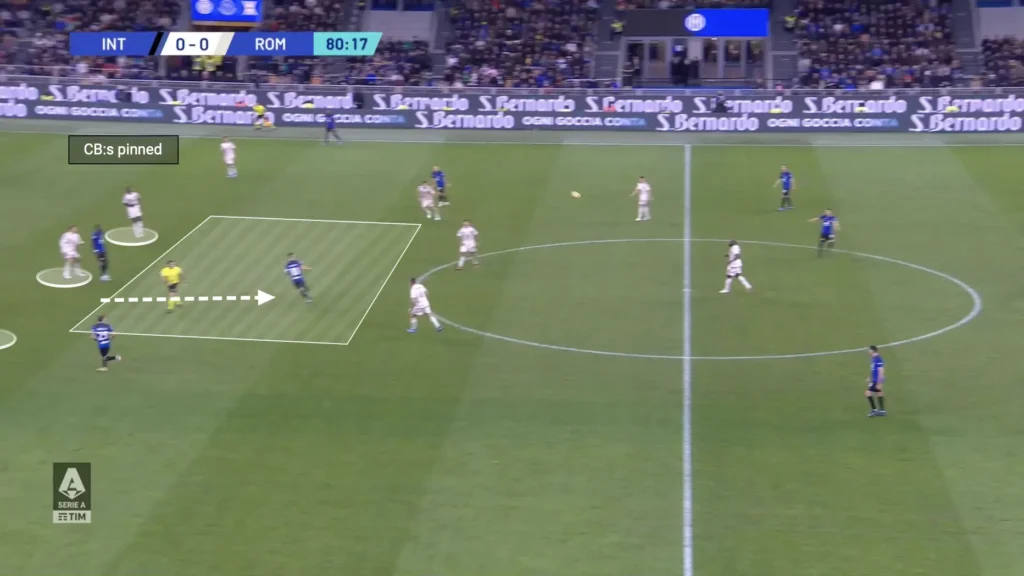
If a center-back pushes up on the dropping striker, a massive space opens up for the other striker to attack and receive a through-ball from backline or midfield.
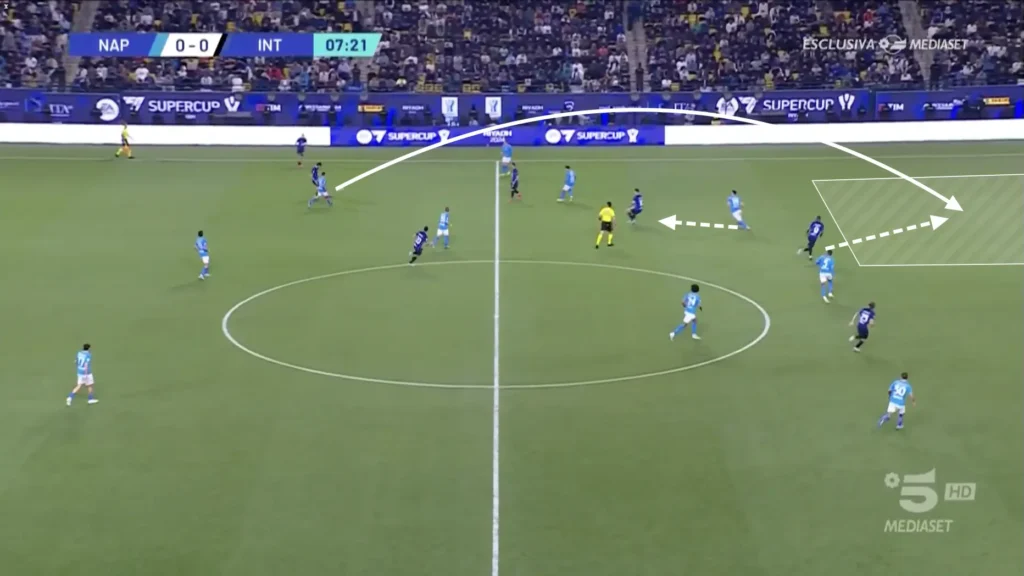
Wingers coming in
In the 1-4-4-2 formation, the movement of the wingers plays a crucial role in creating tactical flexibility and attacking options. When wingers invert, they move from their wide positions into central areas. This movement allows them to link up with the strikers, creating overloads in the middle of the pitch.
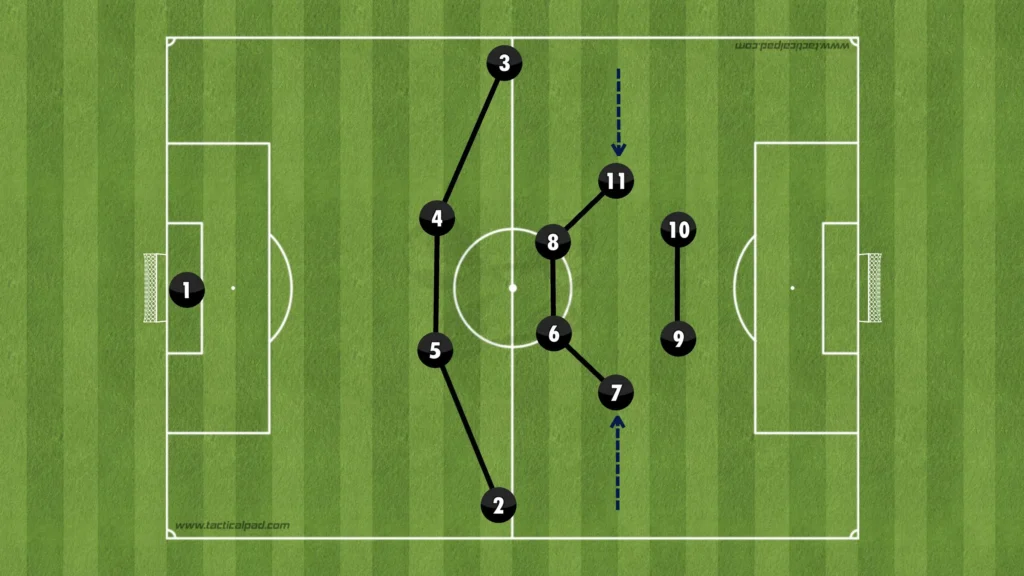
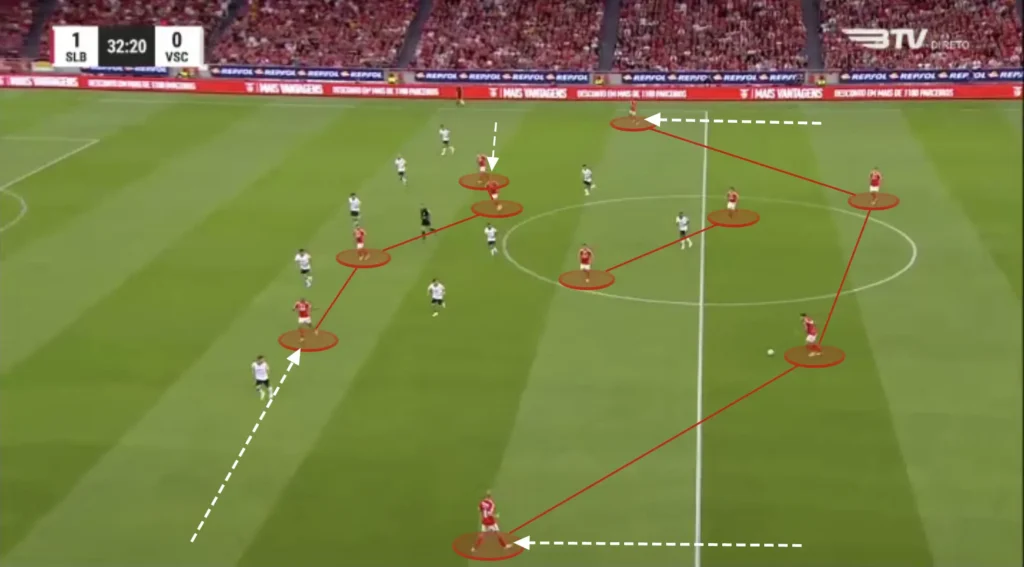
Additionally, inverting wingers can exploit the half-spaces between the opposition’s fullbacks and center-backs, making them more unpredictable and harder to mark. They will be in these “pockets” of space, referring to the spaces between the opposition’s defensive and midfield lines, where the wingers can receive the ball in more advanced positions. By positioning themselves intelligently in these pockets, the wingers can turn quickly and face the opposition’s goal, creating opportunities for through balls, driving runs, or direct shots.
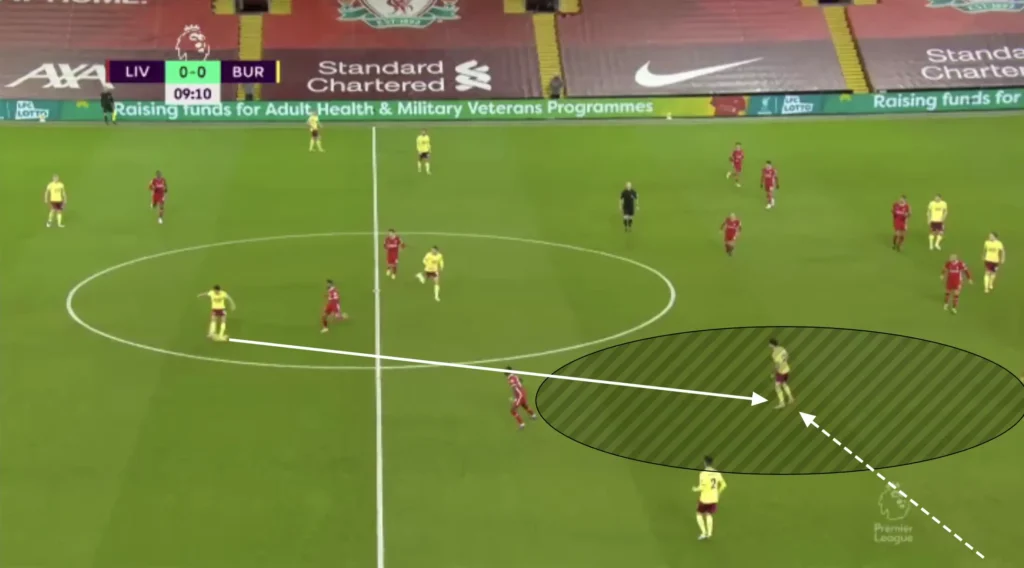
By inverting, wingers in the 1-4-4-2 formation contribute to a more dynamic and fluid attack, increasing their team’s chances of breaking down organized defenses.
Numerical Advantage in the midfield
When the wingers come in, at least four players will be in the midfield, sometimes five if one of the strikers drops. With this, you will almost always have a numerical advantage in the midfield, meaning at least one midfielder will always be open. Having only the two fullbacks out wide and the rest of the players in the middle creates more options in the center and less space between the players. Therefore, 1-4-4-2 teams who invert the wingers should prioritize playing through the middle. You will have one player out wide to pull the opposition apart while the rest create numerical advantages in the midfield areas. This builds good conditions in defensive transitions, allowing more players to counterpress when losing the ball.
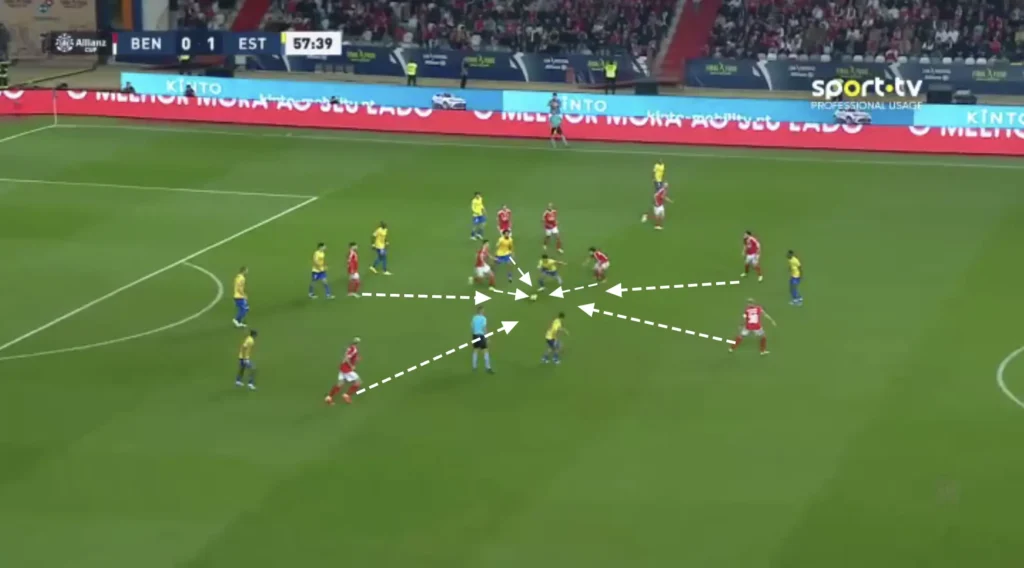
Another purpose for keeping many players in the middle is to shorten the distance between them. This shortens the length of the passes, which naturally shortens the time between passes. This means the opposition players will have less time to push up and press, giving the players more time and control with the ball.
Fullbacks pushing up
The wingers coming in opens up space on the flanks for the fullbacks to push up, providing width and crossing opportunities. By pushing up the field, they stretch the opposition’s defensive line, creating more space for the strikers and wingers to operate. This forward movement also forces the opposing wide players to track back, relieving pressure on the holding midfielders and allowing the team to maintain possession in advanced areas. Additionally, fullbacks in this formation often deliver crosses into the box, adding an extra dimension to the attack and increasing the chances of creating goal-scoring opportunities.
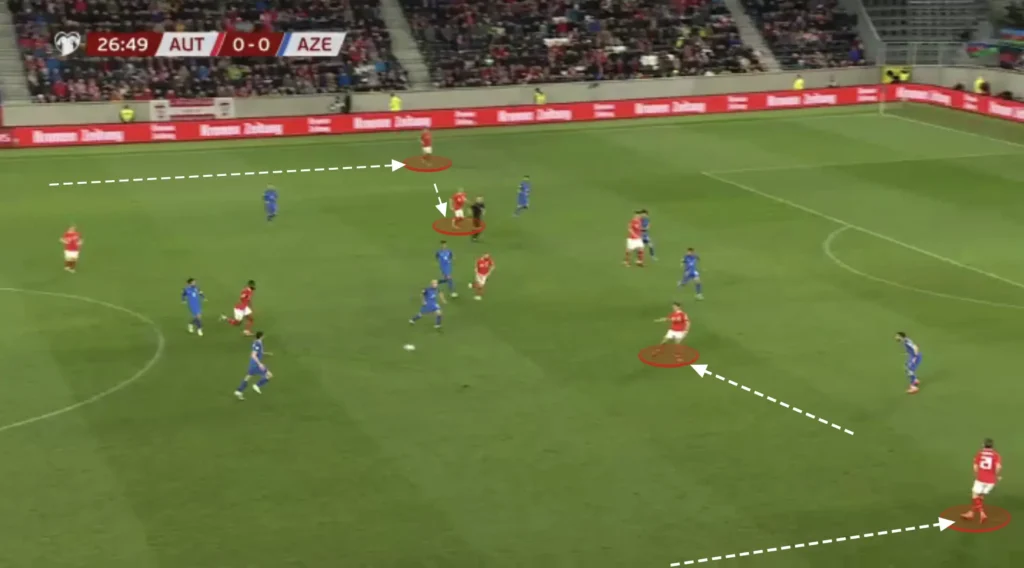
Many players high up the pitch
With the wingers coming in and the fullbacks pushing up, many players will naturally be high up the pitch in attack. Six players will be very high and can, for example, overload the box in crossing situations. The overloads in the box increase the chances of connecting with the cross, as more players present multiple targets for the crosser, making it harder for defenders to mark everyone effectively. Additionally, having multiple players in the box provides options for different types of finishes, whether it’s a header, volley, or a quick tap-in. It also allows for better positioning to react to second balls or rebounds, increasing the likelihood of capitalizing on any defensive errors.
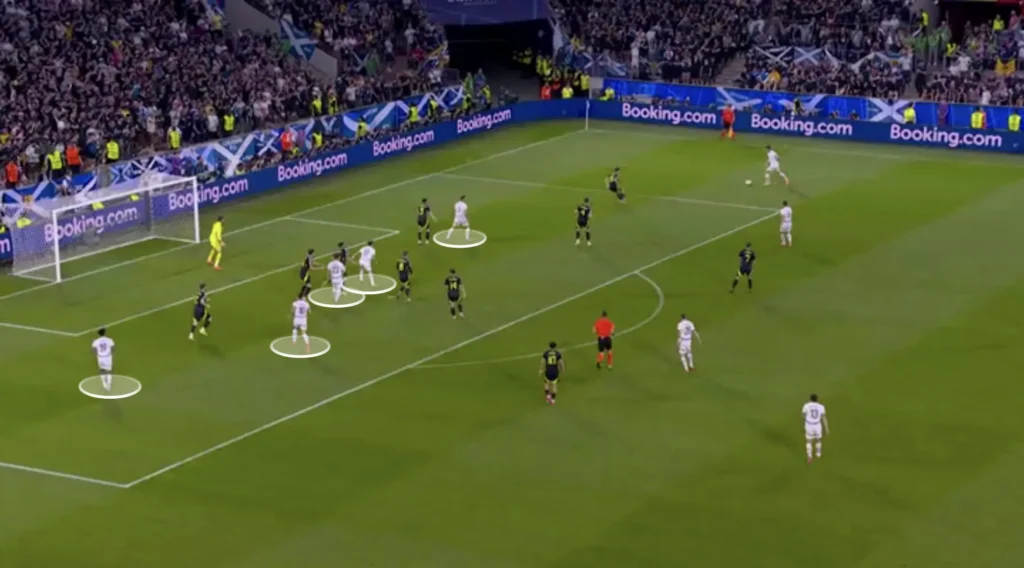
In the 1-4-4-2 formation, the attacking fullbacks can score many goals from crosses at the back post. The opposition fullback will often be preoccupied with an inverted winger, which leaves massive space at the back post for the fullback to attack. The fullback can be found directly or indirectly if no one else connects with the cross.
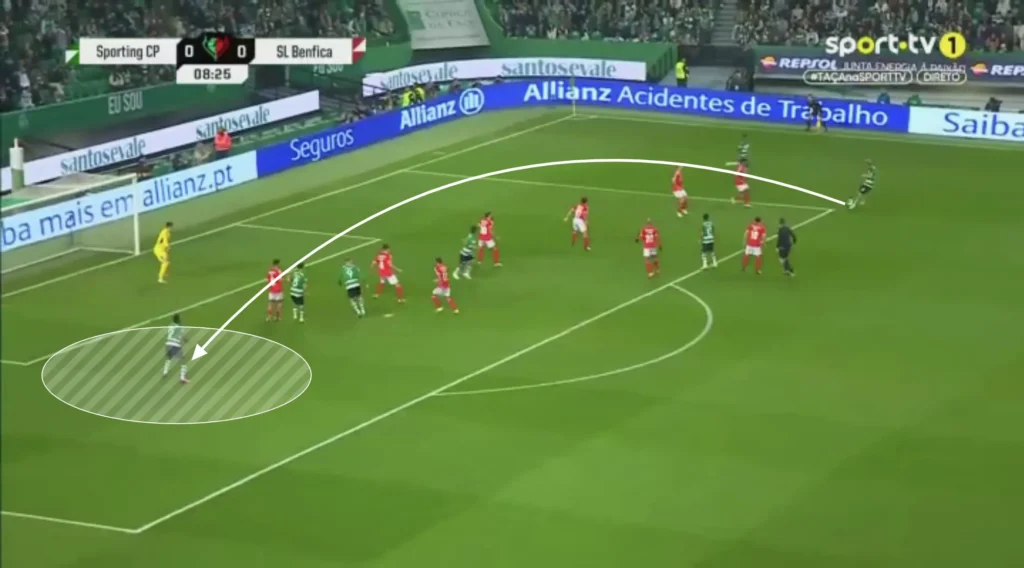
Additionally, the two holding midfielders will be outside the box, ready for the second balls and cut-backs. In crossing situations, the opposition’s defense usually drops down, which opens the space in front of the backline. The holding midfielders can pick up any second balls in these areas, and from there, they can shoot or combine with an attacker to create goalscoring opportunities.
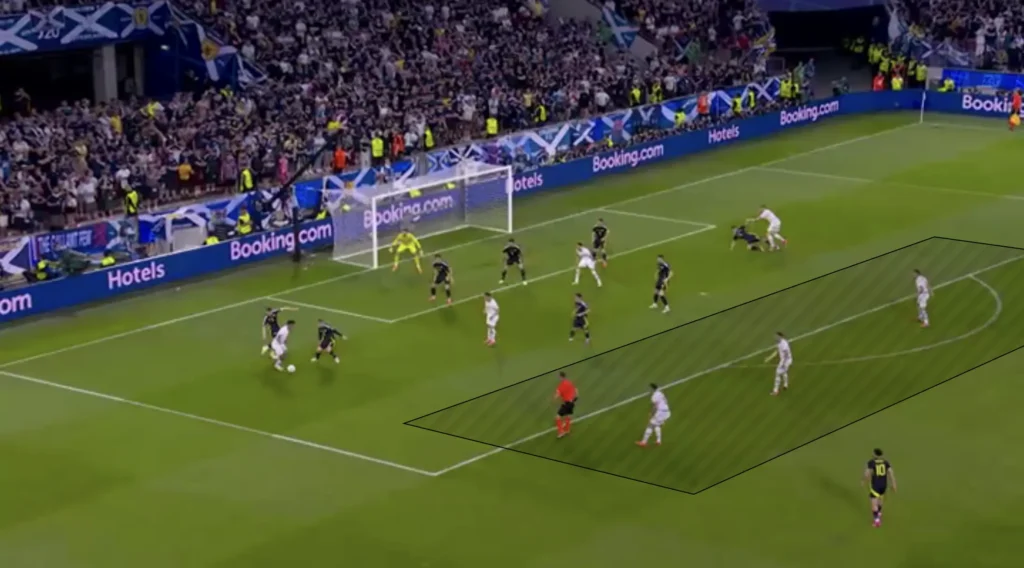
Exposure to counterattacks
The 1-4-4-2 formation, while offering numerous attacking advantages, can leave a team vulnerable to counterattacks. With six players positioned high up the pitch—two strikers, two inverted wingers, and two attacking fullbacks—there is often limited defensive cover, particularly if the team loses possession unexpectedly. The center-backs can find themselves outnumbered or isolated, especially if the holding midfielders are unable to provide adequate support. This exposure can lead to dangerous counterattacking situations for the opposition, who can exploit the open spaces left behind.
Wingers staying wide
In the 1-4-4-2 formation, the wingers can also stay wide, which stretches the opposition’s defense horizontally. By positioning themselves near the touchlines, they force the opposing fullbacks to cover more ground, creating gaps in the defensive line that the central attacking players can exploit. This width also provides valuable crossing opportunities, allowing the wingers to deliver balls into the box for the strikers and advancing midfielders. Additionally, maintaining width helps to open up space in the midfield, giving the team’s playmakers more room to operate and facilitating quicker transitions from defense to attack.
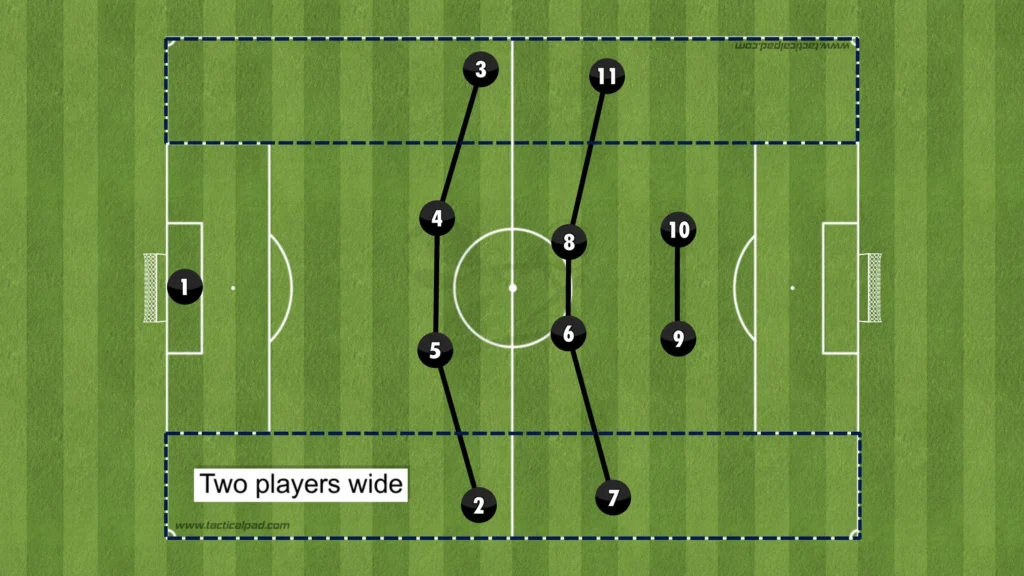
With the wingers wide, the fullbacks will have less freedom to push up. On the one hand, this gives you fewer players high up the pitch, meaning creating goalscoring opportunities could become more difficult. On the other hand, this creates better conditions to defend against counterattacks. When fullbacks stay back, they are better positioned to cover the wide areas, which are often exploited during quick transitions. This positioning also allows them to support the center-backs, reducing the space that attackers can exploit and preventing overloads.
2v1 against the opposition fullback
With the wingers staying wide, the attacking team will have two players on the wing. These two can work together to create chances, mainly by overloading the opposition fullback. When the winger gets the ball on the wing, the fullback can quickly make the overlap, creating a 2v1 against the opposition fullback. If the fullback drops to cover the overlapping run, the winger could cut inside, taking a shot or combining with a midfielder. If the fullback covers the center, the winger can easily play the ball to the overlapping fullback, creating a crossing opportunity.
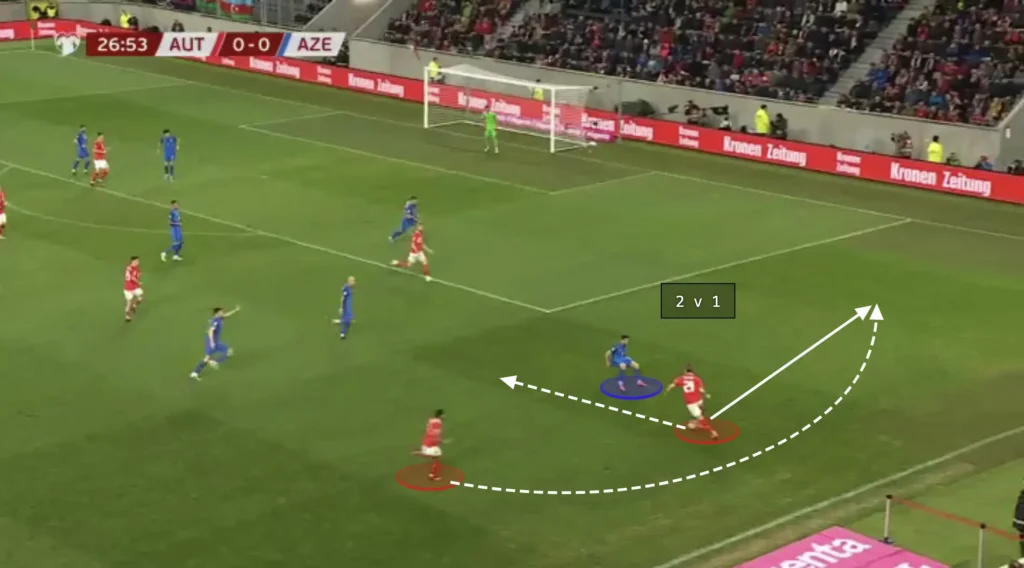
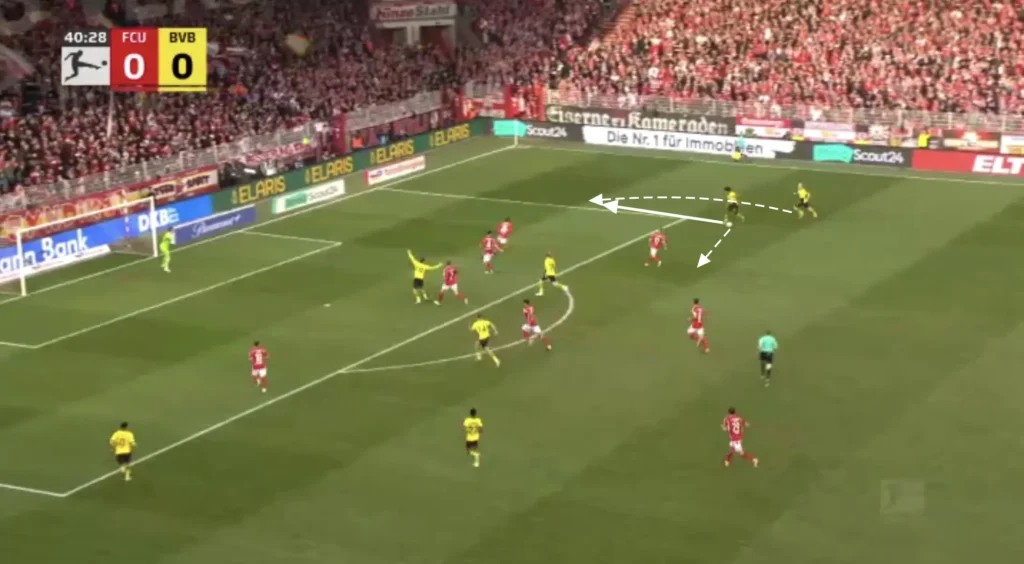
Final Thoughts
In conclusion, the 1-4-4-2 formation offers a balanced and disciplined defensive structure that is effective at stifling opposition attacks through compactness and teamwork. Its emphasis on maintaining tight lines and forcing play wide allows teams to control central areas, making it difficult for opponents to penetrate. However, while the formation provides strong defensive coverage, especially when pressing and counterattacking, it can be vulnerable to teams that effectively switch play or overload the midfield. By understanding these strengths and weaknesses, teams can better implement and adapt the 1-4-4-2 formation to suit their tactical needs, enhancing their overall defensive solidity and counterattacking potential.
